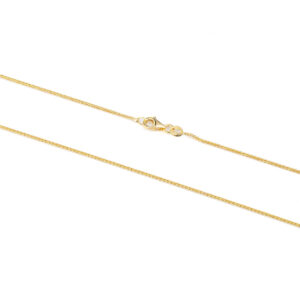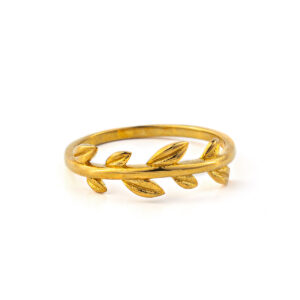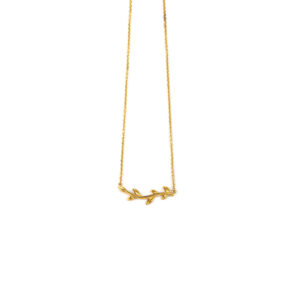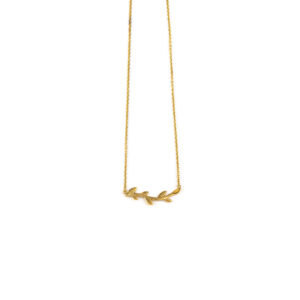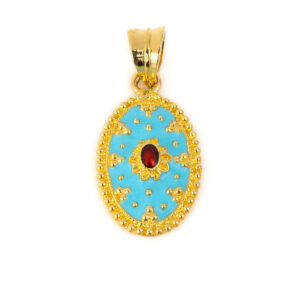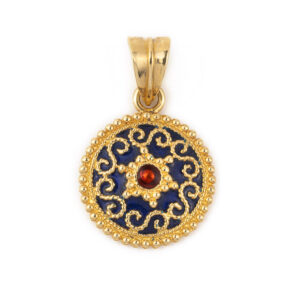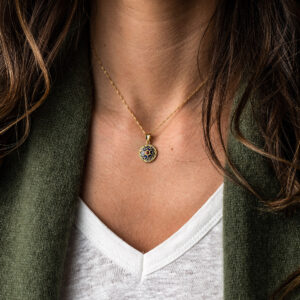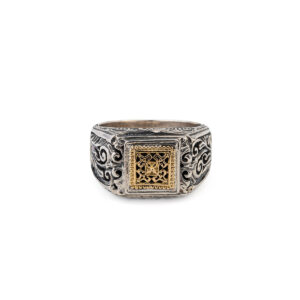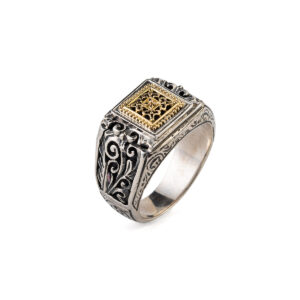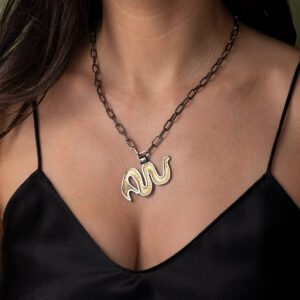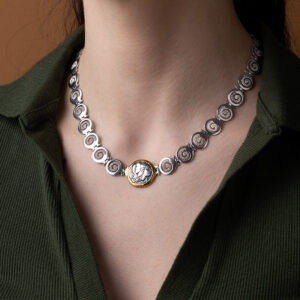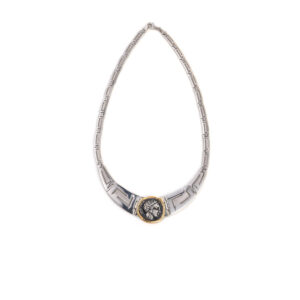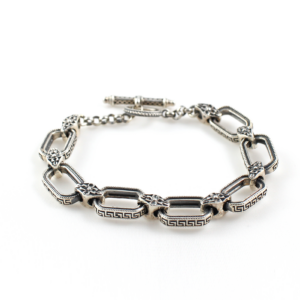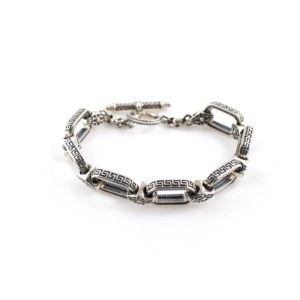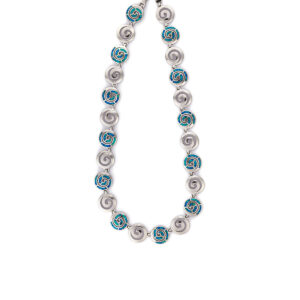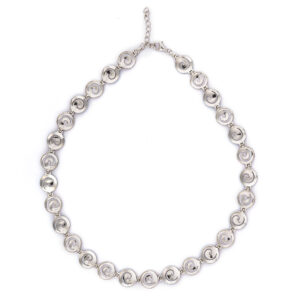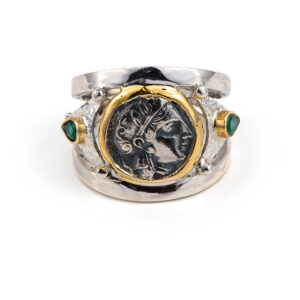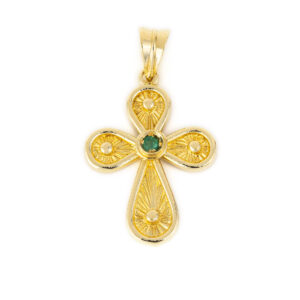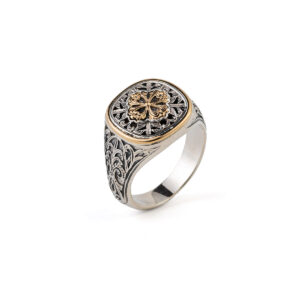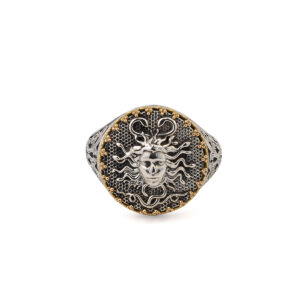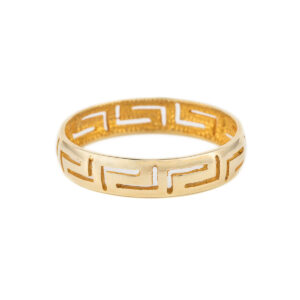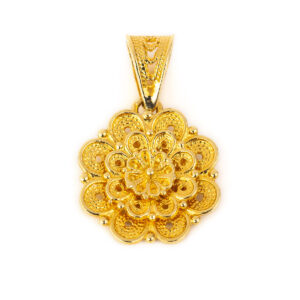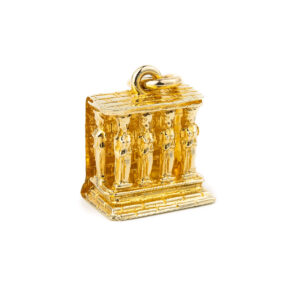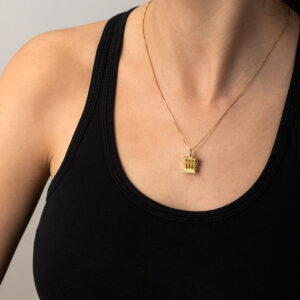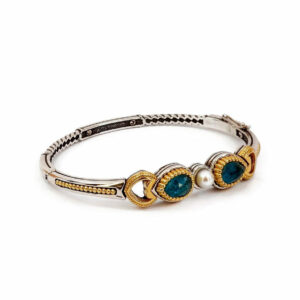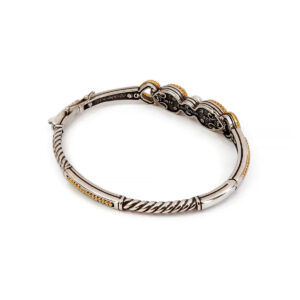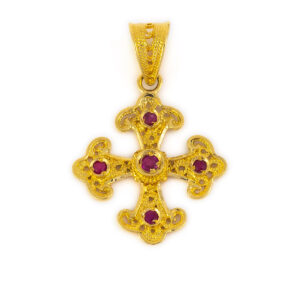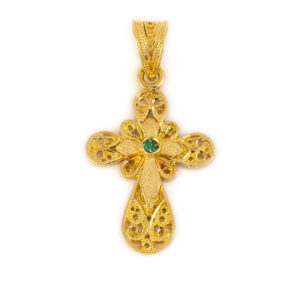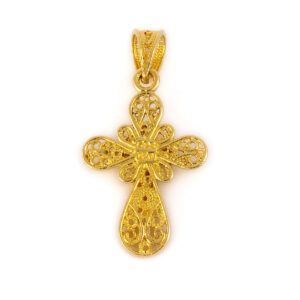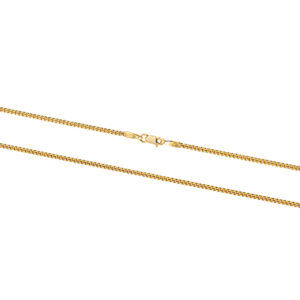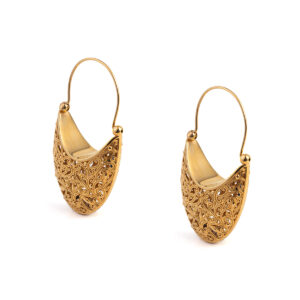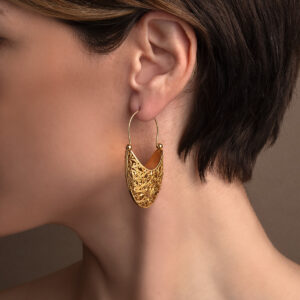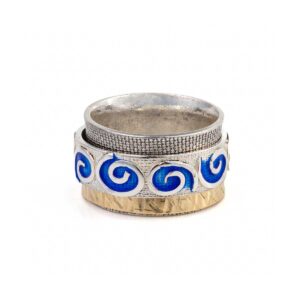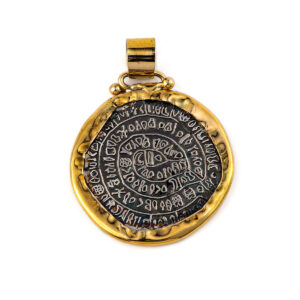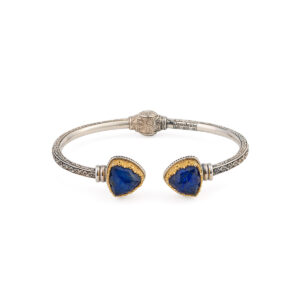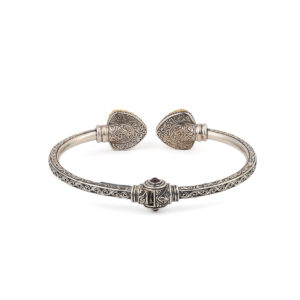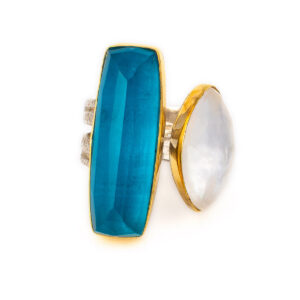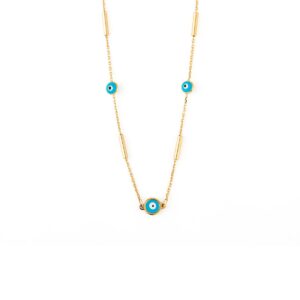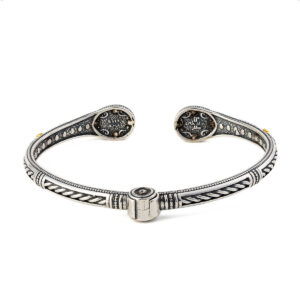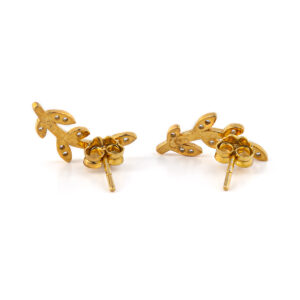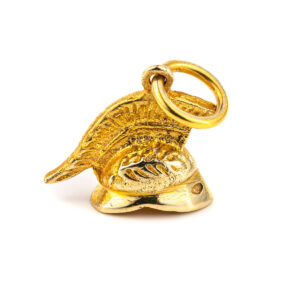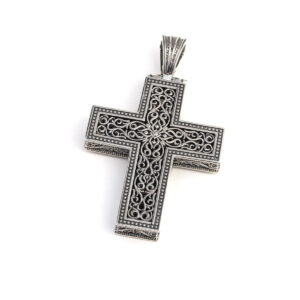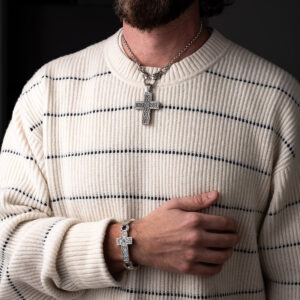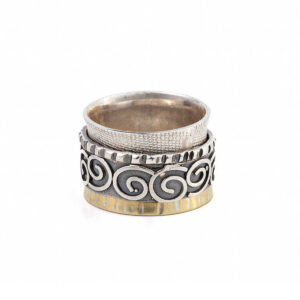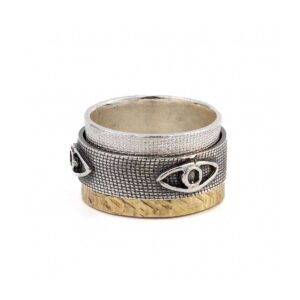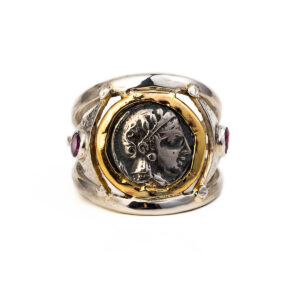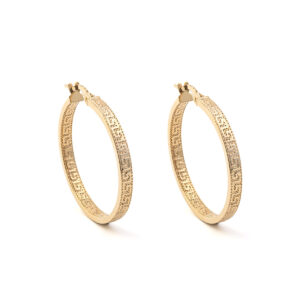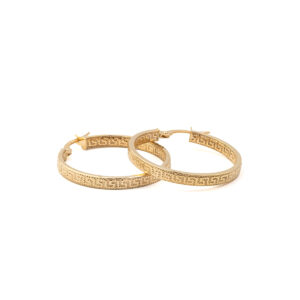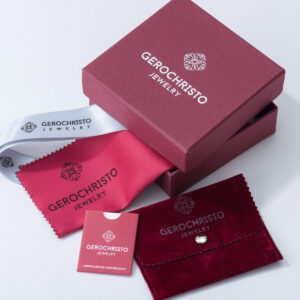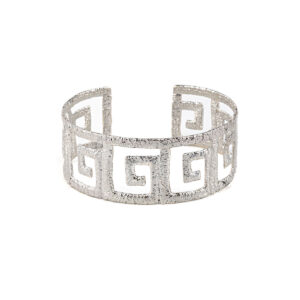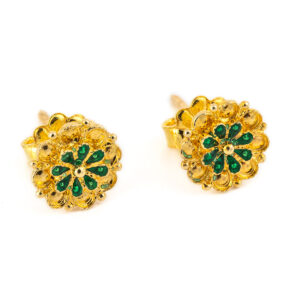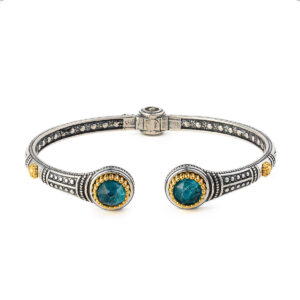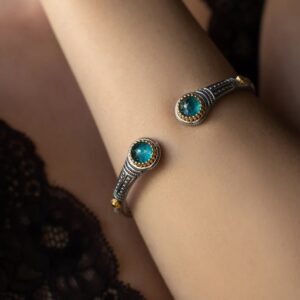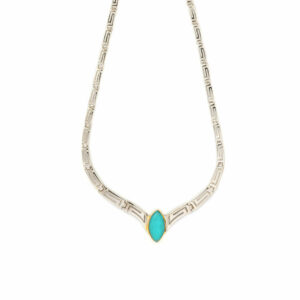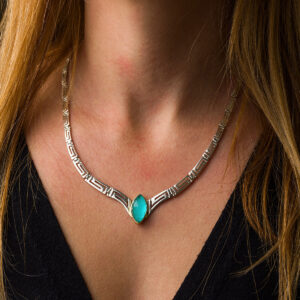Leaf Ring – 18K Solid Yellow Gold
554,00€Ring inspired by the olive leaf symbol.
Made of 18k gold.
The olive wreath also known as kotinos was the prize for the winner at the ancient Olympic Games. It was an olive branch, of the wild- olive tree that grew at Olympia, intertwined to form a circle or a horse-shoe. According to Pausanias it was introduced by Heracles as a prize for the running race winner to honour his father Zeus. In the ancient Olympic Games there were no gold, silver, or bronze medals. There was only one winner per event, crowned with an olive wreath made of wild-olive leaves from a sacred tree near the temple of Zeus at Olympia. Olive wreaths were given out during the 2004 Summer Olympics in Athens in honor of the ancient tradition because the games were being held in Greece.
Leaf Necklace – 18k Yellow Gold
554,00€Made of 18K gold.
A necklace inspired by the olive branch, a symbol of peace, abundance and achievement.
Handmade item.
18K Gold and Turquoise Enamel Pendant
554,00€Byzantine pendant embellished with turquoise enamel and granules of precious metal.
Handmade with great attention to detail. Inspired by Byzantine art.
Made in 18k gold
Granulation (from Latin: granum = “grain”) is a jewellery technique whereby a surface of a jewel is covered with small spheres or granules of precious metal. The technique is thought to have its origins in Mesopotamia about 5,000 years ago.
18k Solid Gold Round Pendant with Blue and Red enamel
554,00€Ancient Greek Round Pendant with blue and red enamel and granules of precious metal. The back side of the pendant has no decoration.
Design inspired by the incredible beauty of historical tradition.
Made in 18k yellow gold.
The chain shown is our 14K Gold Chain in Length 40cm (not included).
Also available with turquoise enamel
Handmade item.
This technique is called Granulation. Granulation (from Latin: granum = “grain”) is a jewellery technique whereby a surface of a jewel is covered with small spheres or granules of precious metal. The technique is thought to have its origins in Mesopotamia about 5,000 years ago. As in all handmade items, there may be small differences in weight and dimensions and this is what makes them unique and precious.
Byzantine ring in 18K Gold and sterling silver
550,00€Byzantine ring in 18K solid Yellow Gold and Sterling Silver.
Handcrafted jewelry made in Greece.
Men’s Collection by Gerochristo
Snake Paperclip Chain Necklace – 925 Sterling Silver
Made of sterling silver 925°.
Handmade in Greece
Explore SNAKE Collection
The snake is an ancient, cross-cultural symbol with a vast range of meanings. It can represent everything from evil and temptation to the universe, eternity, fertility, sexuality, wisdom, healing, and rejuvenation.
In ancient Greek mythology, snakes appear in numerous tales:
According to one legend, Ophion, the serpent, ruled the world until he was overthrown by Cronus and Rhea.
In the Minoan civilization, the Goddess with Snakes, depicted holding a snake in each hand, symbolized wisdom and fertility.
Asclepius, the Greek god of medicine, gained healing knowledge by observing snakes, and his rod, with a snake wrapped around it, continues to be the symbol of medicine today.
Across various cultures and traditions, the snake has remained a powerful symbol, transcending borders and time.
Athena Greek Coin Spiral Necklace – Sterling Silver and Gold
An outstanding necklace inspired by the Ancient Greek tetradrachm.
Made of sterling silver 925° and 14k gold.
Handmade in Greece.
Explore Coins Collection
Goddess Athena and Owl – Athenian silver tetradrachm
Dracma was the currency used in Greece during several periods in its history. The tetradrachm was an Ancient Greek silver coin equivalent to fourdrachmae in Athens it replaced the earlier “heraldic” type of didrachms and it was in wide circulation from ca. 510 to ca. 38 BC. This coin belongs to the so-called “new style Athenian coins” minted between 166 and 64 B.C. and is considered one of the most popular ancient Greek coins which illustrate the portrait of Goddess Athena on the one side and the wisdom owl on the other. Athena is an ancient Greek goddess associated with wisdom, handicraft, and warfare. Athena was regarded as the patron and protectress of various cities across Greece, particularly the city of Athens, from which she most likely received her name. She’s usually shown in art wearing a helmet and holding a spear. Her major symbols include owls, olive trees, and snakes. Her temples were located atop the fortified Acropolis in the central part of the city. The Parthenon on the Athenian Acropolis is dedicated to her, along with numerous other temples and monuments. Her main festival in Athens was the Panathenaia, which was celebrated in midsummer and was the most important festival on the Athenian calendar.
Athena Coin Oval Pendant – 14K Gold and Sterling Silver
Pendant inspired by the ancient Greek tetradrachm.
Made of sterling silver 925° and 14k gold.
Handmade in Greece.
The chain shown in the second picture is our Cable Chain – 925 Sterling Silver and Gold Plated (included).
Explore Coins Collection
Goddess Athena and Owl – Athenian silver tetradrachm
Dracma was the currency used in Greece during several periods in its history. The tetradrachm was an Ancient Greek silver coin equivalent to fourdrachmae in Athens it replaced the earlier “heraldic” type of didrachms and it was in wide circulation from ca. 510 to ca. 38 BC. This coin belongs to the so-called “new style Athenian coins” minted between 166 and 64 B.C. and is considered one of the most popular ancient Greek coins which illustrate the portrait of Goddess Athena on the one side and the wisdom owl on the other. Athena is an ancient Greek goddess associated with wisdom, handicraft, and warfare. Athena was regarded as the patron and protectress of various cities across Greece, particularly the city of Athens, from which she most likely received her name. She’s usually shown in art wearing a helmet and holding a spear. Her major symbols include owls, olive trees, and snakes. Her temples were located atop the fortified Acropolis in the central part of the city. The Parthenon on the Athenian Acropolis is dedicated to her, along with numerous other temples and monuments. Her main festival in Athens was the Panathenaia, which was celebrated in midsummer and was the most important festival on the Athenian calendar.
Athena and Owl Martile Necklace – 925 Sterling Silver and 14K Gold
Necklace inspired by the ancient Greek tetradrachm.
Made of sterling silver 925° and 14k gold.
Handmade in Greece.
Explore Coins Collection
Goddess Athena and Owl – Athenian silver tetradrachm
Dracma was the currency used in Greece during several periods in its history. The tetradrachm was an Ancient Greek silver coin equivalent to fourdrachmae in Athens it replaced the earlier “heraldic” type of didrachms and it was in wide circulation from ca. 510 to ca. 38 BC. This coin belongs to the so-called “new style Athenian coins” minted between 166 and 64 B.C. and is considered one of the most popular ancient Greek coins which illustrate the portrait of Goddess Athena on the one side and the wisdom owl on the other. Athena is an ancient Greek goddess associated with wisdom, handicraft, and warfare. Athena was regarded as the patron and protectress of various cities across Greece, particularly the city of Athens, from which she most likely received her name. She’s usually shown in art wearing a helmet and holding a spear. Her major symbols include owls, olive trees, and snakes. Her temples were located atop the fortified Acropolis in the central part of the city. The Parthenon on the Athenian Acropolis is dedicated to her, along with numerous other temples and monuments. Her main festival in Athens was the Panathenaia, which was celebrated in midsummer and was the most important festival on the Athenian calendar.
Meander Link Bracelet – 925 Sterling Silver – Yianni Jewelry
Byzantine Link Bracelet with meandros designs.
Meandros design is a decorative border constructed from a continuous line, shaped into a repeated motif. Such a design is also called the Greek fret or Greek key design, although these are modern designations. On the one hand, the name “meander” recalls the twisting and turning path of the Meander River in Asia Minor, and on the other hand, as Karl Kerenyi pointed out, “the meander is the figure of a labyrinth in linear form” the meaning is that there is no beginning and no end in some cases so it becomes the symbol of long life and eternity.
Black oxidized background.
Made in 925⁰ sterling silver
Handmade item.
Silver creations of Yianni Jewelry, created by Garbis Khacherian, a silversmith trader since 1987.
Spiral Necklace – Blue Opal 925 Sterling Silver
The spiral is one of the oldest symbols of human spirituality, carved or painted into rocks thousands of years ago. Symbol of movement and progressive development, growth, expansion, cosmic energy, a symbol of the sun. Spirals have been found in burial sites, vases, jewelry, clothing, and weapons… They can be seen in every aspect of nature, like the tides in the oceans, the winds, the plants, and the shells. The spiral phenomenon has been explained through mathematics from the time of Archimedes, the great Greek mathematician.
Design inspired by Ancient Greece.
Made in 925⁰ sterling silver.
Handmade item.
Goddess Athena Coin Ring with Emeralds – 14K Gold and 925 Sterling Silver
Α beautiful ring with Goddess Athena decorated with emeralds.
Made in 14K gold and 925⁰ sterling silver.
Goddess Athena – Athenian silver tetradrachm
Dracma was the currency used in Greece during several periods in its history.
The tetradrachm was an Ancient Greek silver coin equivalent to fourdrachmae in Athens it replaced the earlier “heraldic” type of didrachms and it was in wide circulation from ca. 510 to ca. 38 BC.
The front side of this coin is decorated with Goddess Athena. Athena is an ancient Greek goddess associated with wisdom, handicraft, and warfare.
Athena was regarded as the patron and protectress of various cities across Greece, particularly the city of Athens, from which she most likely received her name. She’s usually shown in art wearing a helmet and holding a spear. Her major symbols include owls, olive trees, and snakes. Her temples were located atop the fortified Acropolis in the central part of the city. The Parthenon on the Athenian Acropolis is dedicated to her, along with numerous other temples and monuments. Her main festival in Athens was the Panathenaia, which was celebrated in midsummer and was the most important festival on the Athenian calendar.
In the classical Olympian pantheon, Athena was regarded as the favorite daughter of Zeus.
14K Gold Byzantine Emerald Cross
540,00€Byzantine Cross embellished with an emerald gemstone in the middle and granules of precious metal.
Handmade with great attention to detail. Inspired by Byzantine art.
Made in 14k gold.
The chain shown is our 14K Gold Chain in Length 40cm (not included).
Filigree is a delicate kind of jewellery metalwork, made with tiny beads or twisted threads, or both in combination, soldered together or to the surface of an object of the same metal and arranged in artistic motifs. The art of filigree dates back to ancient history. The first of the found jewelry in this technique has been found in Mesopotamia and dates to thousands of years BC. In the ancient world and particularly in Asia Minor, this art grew at the highest level.
Granulation (from Latin: granum = “grain”) is a jewellery technique whereby a surface of a jewel is covered with small spheres or granules of precious metal. The technique is thought to have its origins in Mesopotamia about 5,000 years ago.
Byzantine ring in 18K Gold and Sterling Silver
539,00€Byzantine ring in 18K solid Yellow Gold and Sterling Silver.
Handcrafted jewelry made in Greece.
Men’s Collection by Gerochristo
Medusa ring in 18K Gold and sterling silver
536,00€Ring in 18K solid Yellow Gold and sterling silver.
Handcrafted jewelry made in Greece.
Men’s Collection by Gerochristo
14K Yellow Gold Meandros Ring
535,00€14k Gold Ring inspired by the ancient Greek design the Meander or Greek Key.
Meandros design is a decorative border constructed from a continuous line, shaped into a repeated motif. Such a design is also called the Greek fret or Greek key design, although these are modern designations. On the one hand, the name “meander” recalls the twisting and turning path of the Meander River in Asia Minor, and on the other hand, as Karl Kerenyi pointed out, “the meander is the figure of a labyrinth in linear form” the meaning is that there is no beginning and no end in some cases so it becomes the symbol of long life and eternity.
Handmade item.
18K Gold Filigree Byzantine Rosette Pendant
535,00€Byzantine pendant which have the shape of a flower rosette.
This pendant is embellished with a fine filigree and granules of precious metal.
Handmade with great attention to detail. Inspired by Byzantine art.
Made in 18k gold
Rosette flower
The rosette (rose) is a timeless jewel, symbol and amulet. The origin of the term is the Greek word for rose – rodon (ρόδον). Its use began in the Mycenaean era and continues as far as the 2nd millennia BC. The Mycenaean Rosette is a motif that was widespread throughout Mesopotamia, Egypt, Greece and other ancient civilizations. It is inspired by a Mycenaean rosette bead, found at Mycenae, dated to 1400-1300 B.C. The rosette was used extensively in ancient Greek Mycenaean jewels, in architecture, pottery and in sculptures from 1500 BC. Mycenaean rosettes usually had 6 or 8 or 12 leaves, and sixteen leaves during the Macedonian Dynasty. Such details as the rodax shape and the number of leaves tend to vary with the era or beliefs. The rosettes were used to decorate the cloths, belts and wreaths of the Kings. The number of leaves had a symbolic character each time. The four elements of nature (wind, earth, fire, water), the seven wonders of the ancient world or the twelve gods of ancient Greeks and the world domination and radiance of the Kings of Macedonia. They were signs of beauty, purity, eugenics, worship and power. Rosette or Rodax was probably the most popular and favorite decorative element in Mycenaean era, classical antiquity and Byzantine times.
Granulation (from Latin: granum = “grain”) is a jewellery technique whereby a surface of a jewel is covered with small spheres or granules of precious metal. The technique is thought to have its origins in Mesopotamia about 5,000 years ago.
Filigree is a delicate kind of jewellery metalwork, made with tiny beads or twisted threads, or both in combination, soldered together or to the surface of an object of the same metal and arranged in artistic motifs. The art of filigree dates back to ancient history. The first of the found jewelry in this technique has been found in Mesopotamia and dates to thousands of years BC. In the ancient world and particularly in Asia Minor, this art grew at the highest level.
14K Yellow Gold Karyatides Pendant
535,00€Karyatides are sculpted female figures serving as architectural support taking the place of a column or a pillar supporting an entablature on her head.
Made in 14k yellow gold.
Used as a charm or as a pendant.
The chain shown is our 14K Gold Box Chain (not included).
As in all handmade items there may be small differences in weight and dimensions and this is what makes them unique and precious.
Byzantine Cuff Bracelet with Doublet Apatite Gemstone and Natural Pearl
Byzantine bracelet with doublet apatite 7mmX10mm gemstone pear and natural pearl round.
Made of 925⁰ sterling silver and gold plated.
Handmade item.
18K Solid Gold Filigree Cross Pendant with Gemstones
530,00€Byzantine Cross embellished with a fine filigree and is decorated with gemstones and fine filigree. Choose among emeralds, rubies, sapphires or multi-precious stones.
Handmade with great attention to detail. Inspired by Byzantine art.
Made in 18k gold.
The chain shown is our 14K Gold Chain (not included).
Filigree is a delicate kind of jewellery metalwork, made with tiny beads or twisted threads, or both in combination, soldered together or to the surface of an object of the same metal and arranged in artistic motifs. The art of filigree dates back to ancient history. The first of the found jewelry in this technique has been found in Mesopotamia and dates to thousands of years BC. In the ancient world and particularly in Asia Minor, this art grew at the highest level.
18K Gold Emerald Filigree Cross
530,00€Byzantine Cross embellished with fine filigree and a sapphire or ruby or emerald gemstone in the middle.
Handmade with great attention to detail. Inspired by Byzantine art.
Made in 18k gold
Filigree is a delicate kind of jewellery metalwork, made with tiny beads or twisted threads, or both in combination, soldered together or to the surface of an object of the same metal and arranged in artistic motifs. The art of filigree dates back to ancient history. The first of the found jewelry in this technique has been found in Mesopotamia and dates to thousands of years BC. In the ancient world and particularly in Asia Minor, this art grew at the highest level..
Alexander the Great Black Leather Bracelet – 925 Sterling Silver
Sterling Silver Bracelet with genuine black leather insert and 22mm Alexander the Great coin.
Made of 925⁰ sterling silver.
This bracelet comes in a beautiful box.
Handmade item.
Leaf Adjustable Ring with Zircon – 14K Solid Yellow Gold
528,00€Ring inspired by the olive leaf symbol.
Made of 14k gold with zircon.
The olive wreath also known as kotinos was the prize for the winner at the ancient Olympic Games. It was an olive branch, of the wild- olive tree that grew at Olympia, intertwined to form a circle or a horse-shoe. According to Pausanias it was introduced by Heracles as a prize for the running race winner to honour his father Zeus. In the ancient Olympic Games there were no gold, silver, or bronze medals. There was only one winner per event, crowned with an olive wreath made of wild-olive leaves from a sacred tree near the temple of Zeus at Olympia. Olive wreaths were given out during the 2004 Summer Olympics in Athens in honor of the ancient tradition, because the games were being held in Greece.
Kallisto Earrings in Gold Plated silver
525,00€Earrings in Gold plated silver, ancient Greek style.
Handcrafted jewelry made in Greece.
Kallisto Collection by Gerochristo
Blue Spirals Spinner Ring – 925 Sterling Silver and 14K Gold
Athena Coin Round Pendant – 14K Gold and Sterling Silver
Pendant inspired by the ancient Greek tetradrachm.
Made of sterling silver 925° and 14k gold.
Handmade in Greece.
The chain shown in the second picture is our Cable Chain – 925 Sterling Silver and Gold Plated (included).
Explore Coins Collection
Goddess Athena and Owl – Athenian silver tetradrachm
Dracma was the currency used in Greece during several periods in its history. The tetradrachm was an Ancient Greek silver coin equivalent to fourdrachmae in Athens it replaced the earlier “heraldic” type of didrachms and it was in wide circulation from ca. 510 to ca. 38 BC. This coin belongs to the so-called “new style Athenian coins” minted between 166 and 64 B.C. and is considered one of the most popular ancient Greek coins which illustrate the portrait of Goddess Athena on the one side and the wisdom owl on the other. Athena is an ancient Greek goddess associated with wisdom, handicraft, and warfare. Athena was regarded as the patron and protectress of various cities across Greece, particularly the city of Athens, from which she most likely received her name. She’s usually shown in art wearing a helmet and holding a spear. Her major symbols include owls, olive trees, and snakes. Her temples were located atop the fortified Acropolis in the central part of the city. The Parthenon on the Athenian Acropolis is dedicated to her, along with numerous other temples and monuments. Her main festival in Athens was the Panathenaia, which was celebrated in midsummer and was the most important festival on the Athenian calendar.
Precious values of life – Babylonia Bracelet Silver
520,00€Each Babylonia piece is uniquely engraved with a series of signs and symbols which are designed for self expression and individuality. You may select your desired piece, however it is the piece that chooses you.
Made in 935⁰ silver with special nautical knot.
Unique handmade jewelry.
Minoan Phaistos Disc Pendant – 14k Gold and Sterling Silver
Minoan Phaistos Disc Pendant in 14kt gold and 925⁰ sterling silver.
Handmade item. As in all handmade items there may be small differences in weight and dimensions and this is what makes them unique and precious.
The chain shown is our 14K Gold Box Chain (not included).
The Phaistos Disc is a disk of fired clay from the Minoan palace of Phaistos on the island of Crete. Now, the island of Crete is part of modern Greece. The disc was discovered in 1908 by the Italian archaeologist Luigi Pernier in the Minoan palace-site of Phaistos. While it is not clear that it is a script, most attempted decipherments assume that it is; most additionally assume a syllabary, others an alphabet or logography or a calendar.
Gerochristo – Iris Bracelet in Sterling Silver with Lapis Lazuli
515,00€Bracelet in sterling silver with Gold plated parts and doublet stones.
Iris Collection by Gerochristo
Pariba Doublet Ring with pearl – 18K Gold and Sterling Silver
Pariba Ring with a pearl in 18K Gold
A beautiful delicate ring with pariba and a freshwater pearl! So elegant and classy!
Made in 18K gold and sterling silver 925.
Handmade item. As in all handmade items, there may be small differences in weight and dimensions and this is what makes them unique and precious.
Doublet jewelry is a very special piece of jewel due to the way it is compounded. Doublet is a modern and very fashionable design that was invented in order to make stones such as lapis lazuli, turquoise and other non-transparent stones glow and create unique colors from them. There is the unification of two gemstones, which usually consist of quartz and another nontransparent stone. Quartz in this case gives radiance to the other stone and also volume. Due to its composition doublet jewelry needs to be looked after. To keep them in good shape you need to avoid contact with chemicals, such as soap or perfumes. Quartz has the tendency to lose its shininess when touched with sweaty hands, we advise you from time to time to use a soft cloth to polish and give brightness to it.
Evil Eyes Necklace- 14K Gold
514,00€Made of 14K gold.
Handmade in Greece.
Explore Mati Collection
Evil Eye
The symbol and superstition of the evil eye is one of the strongest symbolic images in the world. The earliest known evidence for belief in the evil eye goes back to ancient Greece and Rome. It is supposed to wear off evil to anyone who wears it and various cultures believe in that, however in Greece it’s blue because at that time blue eyes were not so common and were thought to give the evil eye, so the blue is like a mirror to them.
Byzantine Cuff Bracelet with Doublet Amazonite Gemstone
Byzantine bracelet with doublet amazonite 8mm round gemstone.
Made of 925⁰ sterling silver and gold plated.
Handmade item.
Olive Leaf Zircon Earrings – 14K Solid Yellow Gold
514,00€Earrings inspired by the olive leaf symbol.
Made of 14k gold with zircon.
The olive wreath also known as kotinos was the prize for the winner at the ancient Olympic Games. It was an olive branch, of the wild- olive tree that grew at Olympia,intertwined to form a circle or a horse-shoe. According to Pausanias it was introduced by Heracles as a prize for the running race winner to honour his father Zeus. In the ancient Olympic Games there were no gold, silver, or bronze medals. There was only one winner per event, crowned with an olive wreath made of wild-olive leaves from a sacred tree near the temple of Zeus at Olympia. Olive wreaths were given out during the 2004 Summer Olympics in Athens in honor of the ancient tradition, because the games were being held in Greece.
Olive Branch Ring – 14K Solid Yellow Gold
514,00€Ring inspired by the olive leaf symbol.
Made of 14k gold.
The olive wreath also known as kotinos was the prize for the winner at the ancient Olympic Games. It was an olive branch, of the wild- olive tree that grew at Olympia, intertwined to form a circle or a horse-shoe. According to Pausanias it was introduced by Heracles as a prize for the running race winner to honour his father Zeus. In the ancient Olympic Games there were no gold, silver, or bronze medals. There was only one winner per event, crowned with an olive wreath made of wild-olive leaves from a sacred tree near the temple of Zeus at Olympia. Olive wreaths were given out during the 2004 Summer Olympics in Athens in honor of the ancient tradition because the games were being held in Greece.
Spartan Helmet Pendant – 14K Yellow Gold
514,00€Pendant with the Spartan helmet.
Made in 14k yellow gold.
The chain shown is our 14K Gold Chain in Length 40cm (not included).
Used as a charm or as a pendant.
The ancient helmets were used to protect the warriors during the war.
As in all handmade items there may be small differences in weight and dimensions and this is what makes them unique and precious.
Byzantine Orthodox Cross Pendant Silver 925
Made of 925⁰ sterling silver
Handmade in Greece.
Silver creations of Yianni Jewelry, created by Garbis Khacherian, a silversmith trader since 1987.
Explore Yianni Jewellery
The chain shown is our Byzantine Orthodox Cross Pendant Silver 925 (not included)
Spiral Spinner Ring – 925 Sterling Silver and 14K Gold
Eye Spinner Ring – 925 Sterling Silver and 14K Gold
Made of 14k gold and sterling silver 925°.
Handmade in Greece.
Explore Mati Collection
Evil Eye
The symbol and superstition of the evil eye is one of the strongest symbolic images in the world. The earliest known evidence for belief in the evil eye goes back to ancient Greece and Rome. It is supposed to wear off evil to anyone who wears it and various cultures believe in that, however in Greece it’s blue because at that time blue eyes were not so common and were thought to give the evil eye, so the blue is like a mirror to them. Nowadays it’s widely known and has become a trend.
Goddess Athena Ring – 14K Gold and 925 Sterling Silver
Ring inspired by the ancient Greek tetradrachm, depicting Goddess Athena and the Wise Owl. This coin is one of the most popular ancient Greek coins.
Made in 925⁰ sterling silver and 14k gold.
Handmade item.
Goddess Athena and Owl – Athenian silver tetradrachm
Dracma was the currency used in Greece during several periods in its history.
The tetradrachm was an Ancient Greek silver coin equivalent to fourdrachmae in Athens it replaced the earlier “heraldic” type of didrachms and it was in wide circulation from ca. 510 to ca. 38 BC.
This coin belongs to the so-called “new style Athenian coins” minted between 166 and 64 B.C. and is considered one of the most popular ancient Greek coins which illustrate the portrait of Goddess Athena on the one side and the wisdom owl on the other. Athena is an ancient Greek goddess associated with wisdom, handicraft, and warfare.
Athena was regarded as the patron and protectress of various cities across Greece, particularly the city of Athens, from which she most likely received her name. She’s usually shown in art wearing a helmet and holding a spear. Her major symbols include owls, olive trees, and snakes. Her temples were located atop the fortified Acropolis in the central part of the city. The Parthenon on the Athenian Acropolis is dedicated to her, along with numerous other temples and monuments. Her main festival in Athens was the Panathenaia, which was celebrated in midsummer and was the most important festival on the Athenian calendar.
In the classical Olympian pantheon, Athena was regarded as the favorite daughter of Zeus. The owl traditionally accompanies Athena. Because of such association, the owl has been used as a symbol of knowledge and wisdom. The inscriptions contain the city’s “national” appellation (“ΑΘΕ», i.e. “of the Athenians”).
Greek Key Hoop Earrings – 14K Gold
425,00€ – 504,00€Made of 14K gold.
Handmade in Greece
Explore Meandros Collection
Meandros design is a decorative border constructed from a continuous line, shaped into a repeated motif. Such a design is also called the Greek fret or Greek key design, although these are modern designations. On the one hand, the name “meander” recalls the twisting and turning path of the Meander River in Asia Minor, and on the other hand, as Karl Kerenyi pointed out, “the meander is the figure of a labyrinth in linear form” the meaning is that there is no beginning and no end in some cases so it becomes the symbol of long life and eternity.
Gerochristo – Cable Chain handmade in Sterling Silver
504,00€Chain in sterling silver.
Chains by Gerochristo
Meander Cuff Bracelet – 925 Sterling Silver
Bracelet inspired by the ancient meander symbol.
Made of sterling silver 925°.
Handmade in Greece.
Explore Meandros Collection
Meandros design is a decorative border constructed from a continuous line, shaped into a repeated motif. Such a design is also called the Greek fret or Greek key design, although these are modern designations. On the one hand, the name “meander” recalls the twisting and turning path of the Meander River in Asia Minor, and on the other hand, as Karl Kerenyi pointed out, “the meander is the figure of a labyrinth in linear form” the meaning is that there is no beginning and no end in some cases so it becomes the symbol of long life and eternity.
18K Gold Rosette Stud Earrings with Enamel
504,00€Byzantine Earrings which have the shape of the flower rosette.
Handmade with great attention to detail. Inspired by Byzantine art.
Made in 18k gold and green enamel
Rosette flower
The rosette (rose) is a timeless jewel, symbol and amulet. The origin of the term is the Greek word for rose – rodon (ρόδον). Its use began in the Mycenaean era and continues as far as the 2nd millennia BC. The Mycenaean Rosette is a motif that was widespread throughout Mesopotamia, Egypt, Greece and other ancient civilizations. It is inspired by a Mycenaean rosette bead, found at Mycenae, dated to 1400-1300 B.C. The rosette was used extensively in ancient Greek Mycenaean jewels, in architecture, pottery and in sculptures from 1500 BC. Mycenaean rosettes usually had 6 or 8 or 12 leaves, and sixteen leaves during the Macedonian Dynasty. Such details as the rodax shape and the number of leaves tend to vary with the era or beliefs. The rosettes were used to decorate the cloths, belts and wreaths of the Kings. The number of leaves had a symbolic character each time. The four elements of nature (wind, earth, fire, water), the seven wonders of the ancient world or the twelve gods of ancient Greeks and the world domination and radiance of the Kings of Macedonia. They were signs of beauty, purity, eugenics, worship and power. Rosette or Rodax was probably the most popular and favorite decorative element in Mycenaean era, classical antiquity and Byzantine times.
E-Gift Card
50,00€ – 500,00€Get them a present they will love!
Just choose the amount, complete the recipient’s details and type your personal message.
Once the transaction is completed the e-gift card will be sent!
E-gift card is valid for 12 months and redeemable only online at www.greekroots.shop
* It is non-refundable and cannot be exchanged for cash.
Byzantine Cuff Bracelet with Doublet Apatite Gemstone
Byzantine bracelet with doublet apatite 8mm round gemstone.
Made of 925⁰ sterling silver and gold plated.
Handmade item.
Greek Key Necklace with Amazonite – 14K Gold and 925 Sterling Silver
This stunning necklace features an amazonite stone.
Made of 925 sterling silver and 14k gold.
Handmade item. As in all handmade items there may be small differences in weight and dimensions and this is what makes them unique and precious.

